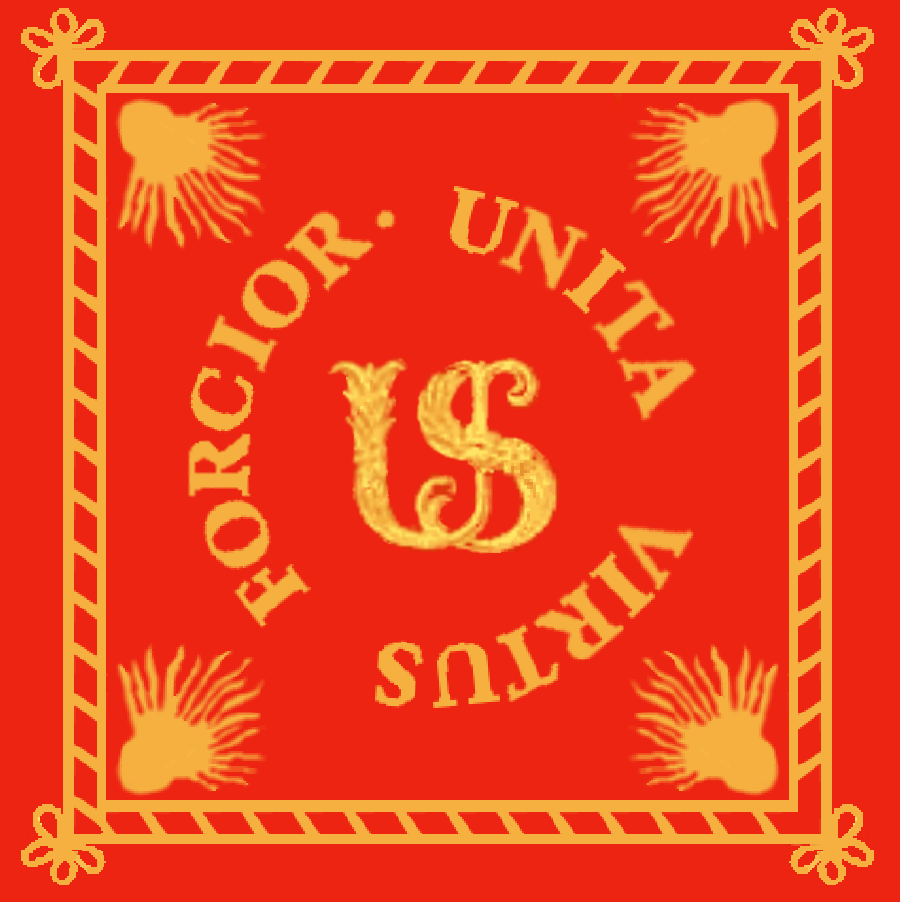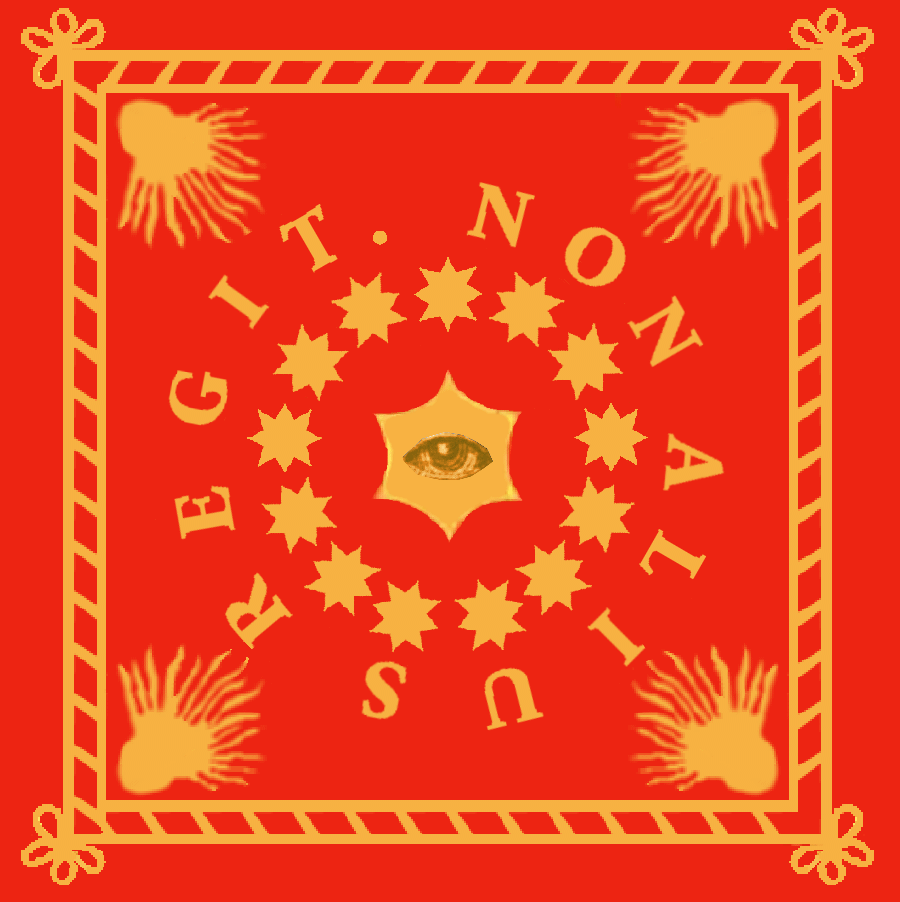


 The standard used by Count Pulaski's Legion was made for Count Kazimierz Michal Waclaw Wiktor Pulaski, the Polish military commander who became known to the American Patriots simply as Casimir Pulaski. The Count served as a military commander for the Bar Confederation (a confederation of Polish Nobles) against the Russians claiming domination over the Polish-Luthuanian Commonwealth from 1767 to 1772. He distinguished himself as an able commander of cavalry in that conflict. On 28 November 1772, the Bar Confederation stronghold at the Zagorz Monastery surrendered to the Russian army, and with its fall, the Bar Confederation was dissolved. Those who could escape did so, fleeing to other European countries and the American colonies; the majority, though, were captured and sent to Siberia to die there. Count Pulaski was fortunate to escape with his life, and he made his way to America after a short sojourn in France. Benjamin Franklin suggested to the Count that he might find life in America more to his liking, and so Pulaski emigrated. A glowing recommendation from Franklin preceeded Pulaski's arrival at Marblehead, Massachusetts on 23 July 1777. On 20 August, the Count arrived at General George Washington's headquarters near Philadelphia. Impressed by the Count's riding skills that he demonstrated for the General, Washington sent a letter to the delegates meeting in the Second Continental Congress requesting that Count Pulaski be given a command in the Continental Army. Before the appointment could take place (15 September 1777), Count Pulaski participated in the skirmishing around Philadelphia, and through his guidance during the Battle of Brandywine on 11 September 1777, Pulaski prevented the annihilation of the fledgling American Cavalry. The orders that came through four days later elevated Count Kazimierz Michal Waclaw Wiktor Pulaski to the rank of brigadier general in the American Cavalry, Continental Line. His regiments would become known as Pulaski's Legion.
The standard used by Count Pulaski's Legion was made for Count Kazimierz Michal Waclaw Wiktor Pulaski, the Polish military commander who became known to the American Patriots simply as Casimir Pulaski. The Count served as a military commander for the Bar Confederation (a confederation of Polish Nobles) against the Russians claiming domination over the Polish-Luthuanian Commonwealth from 1767 to 1772. He distinguished himself as an able commander of cavalry in that conflict. On 28 November 1772, the Bar Confederation stronghold at the Zagorz Monastery surrendered to the Russian army, and with its fall, the Bar Confederation was dissolved. Those who could escape did so, fleeing to other European countries and the American colonies; the majority, though, were captured and sent to Siberia to die there. Count Pulaski was fortunate to escape with his life, and he made his way to America after a short sojourn in France. Benjamin Franklin suggested to the Count that he might find life in America more to his liking, and so Pulaski emigrated. A glowing recommendation from Franklin preceeded Pulaski's arrival at Marblehead, Massachusetts on 23 July 1777. On 20 August, the Count arrived at General George Washington's headquarters near Philadelphia. Impressed by the Count's riding skills that he demonstrated for the General, Washington sent a letter to the delegates meeting in the Second Continental Congress requesting that Count Pulaski be given a command in the Continental Army. Before the appointment could take place (15 September 1777), Count Pulaski participated in the skirmishing around Philadelphia, and through his guidance during the Battle of Brandywine on 11 September 1777, Pulaski prevented the annihilation of the fledgling American Cavalry. The orders that came through four days later elevated Count Kazimierz Michal Waclaw Wiktor Pulaski to the rank of brigadier general in the American Cavalry, Continental Line. His regiments would become known as Pulaski's Legion.
 The Pulaski's Legion Standard was sewn by the Moravian sisters at Bethlehem, Pennsylvania in 1778. It was carried by Pulaski's ensign during the Battle of Savannah, Georgia in the Autumn of 1779, during which battle the Count was killed. The flag was eventually taken, by a lieutenant, to the city of Baltimore, where it was placed under the care of the Peale Museum and later the Maryland Historical Society.
The Pulaski's Legion Standard was sewn by the Moravian sisters at Bethlehem, Pennsylvania in 1778. It was carried by Pulaski's ensign during the Battle of Savannah, Georgia in the Autumn of 1779, during which battle the Count was killed. The flag was eventually taken, by a lieutenant, to the city of Baltimore, where it was placed under the care of the Peale Museum and later the Maryland Historical Society.
 Pulaski's Legion Standard was known as a 'cavalry guidon'. It was constructed of double crimson silk with designs and lettering embroidered in yellow silk thread. On the reverse of the flag are the letters 'U' and 'S', surrounded by the motto: "Unita Virtus Forcior", meaning "Union makes valor stronger". The obverse side of the flag bears an image in the center of an all-seeing eye surrounded by an inner circle of thirteen eight-point stars and an outer circle of the motto: "Non Alius Regit", meaning "No Other Giverns." On both sides of the flag, the edges are outlined by a ribbon decorated with parallelogram shapes, in the corners of which are representations of a sun with rays.
Pulaski's Legion Standard was known as a 'cavalry guidon'. It was constructed of double crimson silk with designs and lettering embroidered in yellow silk thread. On the reverse of the flag are the letters 'U' and 'S', surrounded by the motto: "Unita Virtus Forcior", meaning "Union makes valor stronger". The obverse side of the flag bears an image in the center of an all-seeing eye surrounded by an inner circle of thirteen eight-point stars and an outer circle of the motto: "Non Alius Regit", meaning "No Other Giverns." On both sides of the flag, the edges are outlined by a ribbon decorated with parallelogram shapes, in the corners of which are representations of a sun with rays.


